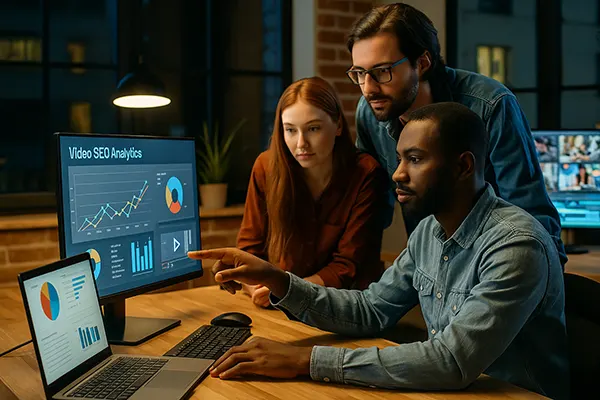
SEO Skills for Video Content and Interactive Formats
As video and interactive media continue to dominate the digital landscape, mastering SEO for these formats is becoming essential for online visibility. Modern search algorithms increasingly prioritise user engagement, multimedia diversity, and accessibility, requiring professionals to expand beyond traditional optimisation techniques. Understanding how to apply SEO principles to video and interactive experiences ensures that creative content not only attracts viewers but also achieves high search performance in 2025.
Understanding the Foundations of Video SEO
Search engines evaluate videos based on metadata, engagement signals, and technical optimisation. To improve ranking potential, creators must ensure that every video includes descriptive titles, captions, and structured data. Adding relevant keywords naturally within these elements helps search algorithms contextualise the content, making it easier to display in relevant search results.
Equally important is the quality of the video itself. High-resolution visuals, professional editing, and accurate transcripts improve accessibility and viewer retention, two key factors influencing visibility. Subtitles also assist users watching without sound and enhance performance on social platforms, where muted autoplay is common.
Video hosting choices impact SEO performance as well. Platforms like YouTube and Vimeo are indexed differently than self-hosted videos. Integrating videos within your own site while maintaining fast load times ensures that engagement benefits your domain authority rather than redirecting users elsewhere.
Techniques for Enhancing Video Discoverability
Optimising video sitemaps is an advanced yet crucial step. Including schema markup allows search engines to understand duration, description, and target audience, increasing the chance of appearing in rich snippets and Google Video tabs. This structured data plays a vital role in boosting impressions and click-through rates.
Thumbnails also serve as powerful visual cues. A clear, high-contrast image that reflects the video’s theme can significantly increase engagement. While often overlooked, custom thumbnails help differentiate quality content from automatically generated previews that may not capture the video’s essence.
Additionally, engagement metrics such as average watch time, likes, and comments provide valuable ranking signals. Encouraging users to interact with content, subscribe, or share ensures sustained organic visibility across both video platforms and general search results.
Integrating SEO with Interactive Content
Interactive elements—such as quizzes, infographics, and clickable storytelling—are powerful tools for improving user engagement and dwell time. These features not only entertain but also contribute to SEO performance by increasing session duration and reducing bounce rates, two factors closely monitored by search engines.
To optimise interactive formats effectively, focus on user experience. All interactive features must load quickly, be mobile-responsive, and remain accessible to assistive technologies. Structured content with clear navigation paths ensures that search crawlers can interpret complex elements accurately, maintaining SEO integrity.
Keyword strategy also extends into interactivity. Using descriptive text within buttons, menus, and captions helps algorithms understand the thematic context. This enhances semantic relevance, especially when combined with internal linking that guides users deeper into related sections of the website.
Best Practices for Interactive Engagement
Personalisation is one of the most effective strategies in interactive SEO. By adapting content based on user behaviour, preferences, or geolocation, creators can provide more meaningful experiences that improve conversion rates and retention. Interactive tools like calculators or product selectors can be optimised with relevant metadata to appear in specialised search results.
Analytics integration is another key component. Tracking how users interact with each element provides insights into which sections drive engagement or need improvement. These insights enable continuous optimisation based on measurable data rather than assumptions.
Finally, embedding social sharing functionality encourages user participation and expands content reach. Each share generates additional backlinks and signals of credibility, which positively influence search rankings and overall brand visibility.

Emerging SEO Trends in Multimedia Optimisation
As artificial intelligence advances, search engines are becoming increasingly capable of analysing video and interactive content contextually. Features such as automatic speech recognition and visual analysis now allow algorithms to interpret audio and imagery directly, making accurate metadata more critical than ever.
Voice search is also reshaping how users discover multimedia content. Ensuring that titles and descriptions align with conversational search patterns helps capture traffic from smart assistants and voice-enabled devices. This trend highlights the importance of natural language optimisation and long-tail keyword integration.
In 2025, the convergence of AI and SEO will demand greater emphasis on authenticity and user trust. Content that demonstrates clear expertise, transparent creation processes, and ethical data handling will gain an advantage. Aligning with E-E-A-T principles—Experience, Expertise, Authoritativeness, and Trustworthiness—remains a key factor in sustainable SEO success.
Future-Proofing Your Multimedia SEO Strategy
Continuous education and experimentation are vital for maintaining competitive SEO performance. As algorithms evolve, testing new formats, analysing metrics, and updating strategies ensure adaptability. Investing in SEO tools that specialise in multimedia analytics can streamline this process and uncover new opportunities.
Collaboration between technical SEO specialists, designers, and content creators is essential for achieving holistic optimisation. Each team brings unique insights—technical accuracy, creative appeal, and strategic clarity—that combine to deliver measurable results in visibility and engagement.
Ultimately, mastering SEO for video and interactive formats is about understanding both audience behaviour and algorithmic evolution. By balancing creativity with technical precision, professionals can create immersive content that ranks effectively and remains relevant in a rapidly changing digital environment.





